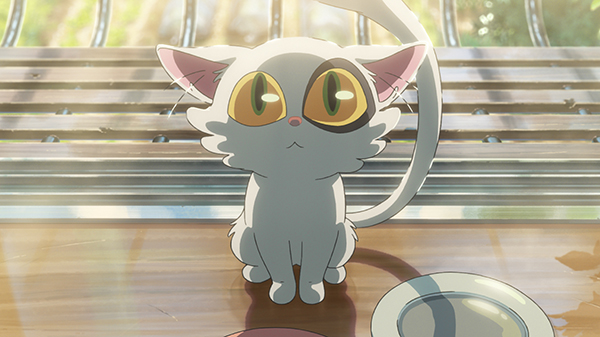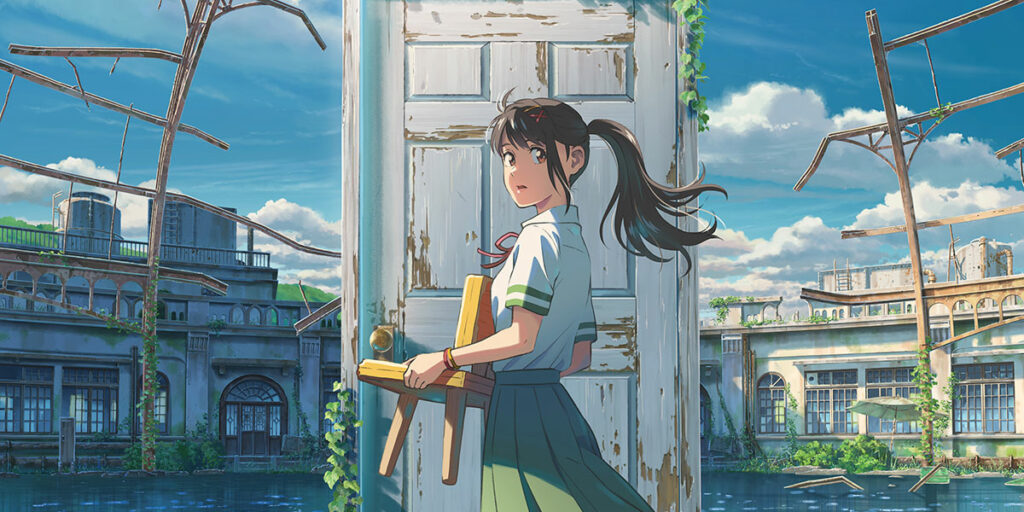Suzume boasts ample craftmanship and ambition from Shinkai Makoto, but it merely rushes viewers through its doors without time for anything to sink in.
God, I hate the localized title. Look at the original title, Suzume no Tojimari, which roughly translates to “Suzume’s Door Closing.” Immediately it invites questions. What is this door? Why does Suzume have to close it? Is the door literal or is it a metaphor, such as Suzume closing the door on her ex-boyfriend? But then we have the actual title, Suzume. Just SUZUME. Nothing about it invites mystique or gives any clues as to what the movie is about, to the point where you could mistake it for a documentary about some historical figure named Suzume. Fire the translator.
Suzume (ugh) is the newest animated film from director Shinkai Makoto, famous for the 2016 hit Your Name. It follows high school girl Iwato Suzume (Hara Nanoka), who one day meets a mysterious young man Munakata Souta (Matsumura Hokuto). A mishap at a nearby ruin reveals Souta is in charge of closing certain doors all across Japan that run the risk of letting out a giant supernatural “worm”. After that, a run-in with a cat-like creature Daijin (Yamane Ann) leaves Souta trapped in Suzume’s childhood chair, leading the two to chase the cat across the country to set things right.
Suzume’s biggest strength has to be its animation. Every frame is vibrant and the character designs are simple yet memorable. It even made good use of 3D CG effects. Typically, CG in 2D animation blend in about as well as KFC chicken wings in a tonkatsu restaurant, but here, it works because it’s mainly used for the worm. After all, the worm is supposed to look alien and horrifying, which is exactly my reaction to 3D in anime, so it enhances rather than distracts.
But movies aren’t supermodels: you can’t just look pretty for two hours and call it a day, you need actual content to stick with viewers. And in that regards, Suzume is certainly very ambitious. Disasters are a key theme. Its road trip format takes Suzume and Souta to different places abandoned or ruined by bad events, and how the locals learned to cope and live on. Earthquakes keep happening, something Japan is unfortunately familiar with, and the movie shows the pain it inflicts on people.

Or at least, that’s how things would have been if the movie actually realized its ambition. But Suzume sadly suffers from one massive issue with its execution, that being its pacing. Throughout the movie, especially the first half, I thought I was watching an abridged version. People carry on conversations slightly too fast, like everyone just realized they need to use the restroom and are trying to escape.
Because of this, the people Suzume meets along her journey feel like oddly placed jenga blocks in the story. They should fit in and support the central theme, as it’s implied their lives are connected to local disasters. But since they are sloppily skimmed over, we don’t even get to know their favorite ramen flavor before Suzume runs off to the next Daijin sighting facebook post. (Yes, that’s how they track it)
This also makes the plot, mainly in the first half, rather repetitive. Suzume can be broken up into two parts. The first hour or so follows a road trip format, while the rest deals more about actually stopping the worm. During the road trip section, Suzume meets new side characters, then closes a door. Because this format repeats in relatively quick succession while not letting the locations sink in properly, the movie’s pattern starts to feel derivative.
But even more detrimental is how this pacing affects its main characters and their central conflicts. Now, I don’t dislike Suzume – she is daring and also is endearing with several comedic moments – but that is because I don’t know her enough to like or dislike her. We only get to see about three minutes into her normal life before she gets wrapped up in the door closing business, even elementary school icebreakers give a more thorough summary of what a person is like.
This also means that Suzume’s motivations feel flimsy. I know Souta got turned into a chair in front of her, and that would cause some concern, but does that really justify immediately setting off on a trip across the country? It would help if we got to know what sort of person she was. Is she incredibly responsible to a fault? Does she feel bored with her normal life and would jump at any opportunity to live abnormally? Any justification would have been better.
You could say that she feels responsible for what happened to Souta, but the issue is that the movie tries to imply Suzume’s feelings as love rather than camaraderie. Yet the film moves so fast, with not even a Disney-style musical number to sell their relationship. Not to mention it’s rather hard to discern budding romantic feelings between a girl and a chair.
Then there are conflicts that just feel completely out of nowhere. In the third act, Suzume gets into an argument with her aunt Tamaki (Fukatsu Eri) about their respective frustrations after Suzume lost her mother and Tamaki took her in. But this happens with practically zero buildup of that dissent between them. Do you want to know how much time the movie spent on what their relationship was like at the beginning of the movie? Thirty-five seconds. And even then they didn’t argue, they just behaved like a normal happy family.
On a different note, it’s notable that this movie seems to be aimed mostly for Japanese audiences, with its allusions to disasters like earthquakes or tsunamis. This isn’t necessarily a positive or a negative, just a factor to consider. But if you don’t live in an area that requires you to stock an earthquake bunker, you may find some of its themes harder to relate to.
Suzume is just too overstuffed for its own good. It wants to deal with the theme of disasters. It wants to be a road trip showing different sorts of people. It wants to be a fantastical romance. It wants to cover Japanese mythological backgrounds. It wants to add in family drama. At that point, the story would have worked better as a TV show or at least a two-part movie, to allow for both its main and side characters to be more fleshed out instead of being RPG NPCs.
Again, I can admire this film’s ambition. And despite everything I said, I didn’t have a bad time with Suzume. It looks beautiful and its characters aren’t unlikeable, which gives me a baseline investment. But while it’s not a bad time, it’s a rather shallow one. It’s like going to a swimming pool, but only taking small dips and splashes without fully taking a dive. At that point, you’d have been just as good with your bathtub and a few bath bombs.
Suzume is now available to watch on digital and on demand.

